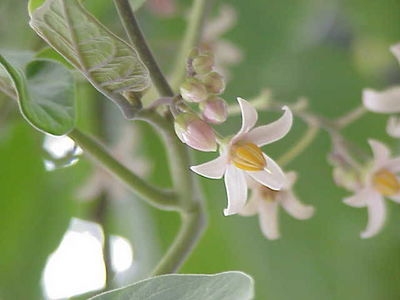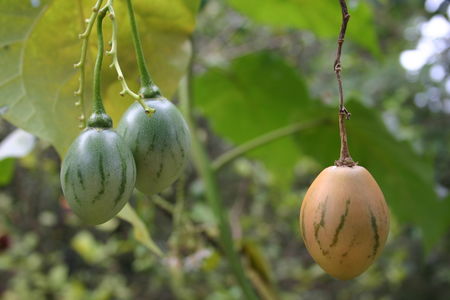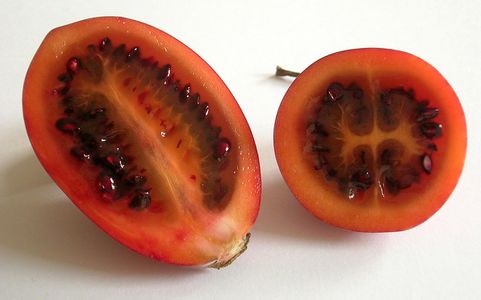Solanum betaceum
Solanum betaceum Cav.
| Ordre | Solanales |
|---|---|
| Famille | Solanaceae |
| Genre | Solanum |
2n = 24
Origine : Bolivie, Argentine
sauvage ou cultivé
| Français | tamarillo |
|---|---|
| Anglais | tamarillo |
Résumé des usages
- fruit comestible
Description
Noms populaires
| français | tamarillo, tomate en arbre |
| anglais | tamarillo, tree tomato |
| allemand | Baumtomate |
| néerlandais | boomtomaat, tamarillo |
| italien | pomodoro arboreo, pomodoro del Perú |
| espagnol | tomate de árbol, limatomate, tamarillo |
| portugais | tomate-de-árvore, tomate-arbóreo, tomate-maracujá, tomate-japonês, tomate-francês, tomate-inglês |
Classification
Solanum betaceum Cav. (1799)
synonyme :
- Cyphomandra betacea (Cav.) Sendtner (1845)
Cultivars
Histoire
D'après GRIN, le tamarillo serait originaire du nord de l'Argentina (Jujuy, Salta, Santiago del Estero, Tucuman) et du sud de la Bolivia (Tarija). Il s'est répandu à l'état cultivé dans toutes les Andes. Le fait qu'on ne lui connaît pas de nom amérindien et qu'il s'est diffusé sous le nom espagnol de tomate de árbol plaide pour une diffusion post-colombienne. La Nouvelle-Zélande a créé le nom tamarillo et l'a lancé commercialement sur les marchés européen et nord-américain.
Usages
Références
- Chauvet, Michel, 2018. Encyclopédie des plantes alimentaires. Paris, Belin. 880 p. (p. 703)
- Hernández Bermejo, J.E. & León, Jorge (eds), 1994. Cultures marginalisées : 1492 : une autre perspective. Rome, FAO. 354 p.
- Lost crops of the Incas. Little-known plants of the Andes with promise for worldwide cultivation. 1989. Washington, National Academy Press. 415 p.
- Morton, Julia, 1987. Fruits of warm climates. Miami, Julia F. Morton. en ligne à Purdue
- Prohens, Jaime & Nuez, Fernando, 2001. The Tamarillo (Cyphomandra betacea): A Review of a Promising Small Fruit Crop. Small Fruits Review, 1 (2): 43–68. doi:10.1300/J301v01n02_06




